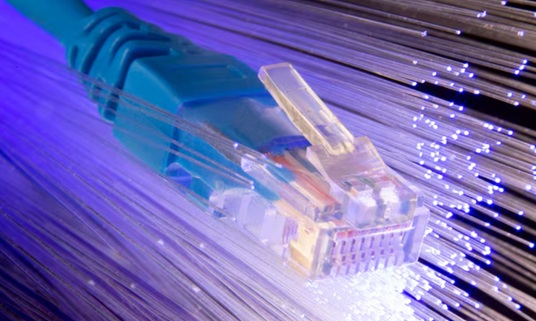
Choosing between fiber and cable isn’t just about headline speeds—it’s about reliability, upload performance, scalability, and how well your connection holds up when it matters most. Here’s a clear, business-focused breakdown to help you make the right call.
Speed and Latency
- Fiber: Commonly offers symmetrical speeds (e.g., 300/300 Mbps, 1/1 Gbps, even multi-gig) with consistently low latency. That symmetry matters for cloud apps, video calls, large file uploads, backup, and hosting services.
- Cable: Typically delivers fast downloads but slower uploads (e.g., 600 Mbps down / 20–35 Mbps up). Browsing and streaming feel quick, but heavy uploading—daily file syncs, live video, or off-site backups—can bottleneck.
Verdict: If your team pushes data to the cloud all day, fiber’s symmetry pays off.
Reliability and Uptime
- Fiber: Uses light over glass, which is less susceptible to electrical interference. Business-grade fiber often comes with robust SLAs (service level agreements), faster repair windows, and proactive monitoring.
- Cable: Coax networks can be more affected by local congestion, signal noise, and power fluctuations. SLAs may be lighter on response/repair times.
Verdict: For mission-critical operations where downtime is expensive, fiber’s stability and SLA terms are real advantages.
Scalability and Future-Proofing
- Fiber: Scales cleanly from hundreds of Mbps to multi-gig, often without major infrastructure changes. Great for growing headcounts, new sites, or heavier cloud adoption.
- Cable: Can scale download speeds, but upload ceilings and shared-segment constraints can appear as you grow.
Verdict: If you expect rapid growth, fiber provides more headroom.
Uploads, Backups, and VoIP/Video
- Fiber: Symmetrical upload speeds keep daily backups, real-time collaboration, VoIP, and video conferencing smooth and consistent—even at peak hours.
- Cable: Works for smaller teams, but high-usage periods (all-hands calls, large media uploads) can cause jitter and call quality dips.
Verdict: For creative teams, remote-first operations, or anyone living in video calls, fiber wins on quality.
Security and Consistency
- Fiber: Harder to tap and less vulnerable to electromagnetic interference. Consistent throughput supports security tools that analyze traffic in real time without slowing users.
- Cable: Secure when configured correctly, but traffic variability can hinder deep inspection or large patch pushes during busy windows.
Verdict: Both can be secure, but fiber’s consistency helps your security stack perform at its best.
Cost and Availability
- Fiber: Monthly costs can be higher, with potential one-time construction fees if your building isn’t “lit.” That said, the ROI can be strong if downtime is costly.
- Cable: Widely available and cost-effective. Ideal for small teams, backup lines, or temporary sites.
Verdict: If fiber is easily available and you rely on the internet for revenue-generating work, the premium is often justified. If budget is tight and your needs are lighter, cable remains a solid choice.
Use-Case Snapshots
- Creative/media firms, engineers, architects: Large uploads to clients and clouds → Fiber.
- Distributed teams heavy on Zoom/Teams: Stable, low-jitter video → Fiber.
- Retail, small office, point-of-sale, email, web: Moderate usage with tight budgets → Cable can suffice.
- Healthcare/finance with strict uptime: SLA + fast repair times → Business fiber preferred.
- Redundancy planning: Pair fiber primary with cable backup (or vice versa) plus automatic failover.
Quick Decision Framework
Ask these five questions:
- How critical is upload speed? (Cloud workflows, daily backups, large file sharing)
- What’s the cost of downtime? (Revenue loss, SLA obligations, reputational risk)
- Are we growing fast? (Headcount, sites, data volumes)
- What’s available in our building? (Construction lead times and fees matter)
- Do we need redundancy? (Consider dual providers and an SD-WAN or failover router)
Implementation Tips
- Test before you commit: Run latency/jitter tests during peak hours.
- Prioritize SLAs: Look for clear uptime guarantees and mean time to repair.
- Right-size now, plan for more: Choose a tier that meets today’s needs with an easy upgrade path.
- Enable QoS: Prioritize VoIP and conferencing traffic so calls stay clear.
- Document and monitor: Track tickets, uptime, and performance to validate value over time.
Bottom Line
If your business relies on cloud apps, constant collaboration, or large uploads, fiber delivers superior performance, reliability, and scalability. For lighter use and tighter budgets, cable remains a dependable, widely available option—especially as a backup circuit. Choose based on your workload, growth outlook, and the real cost of downtime, and you’ll land on the connection that actually supports how your team works.
This post was written by a professional at Centra IP Networks. Centra IP Networks, established in 2005, is a trusted nationwide telecommunications provider specializing in solutions for small and medium-sized businesses. From Business Phone Systems Tampa FL companies rely on to advanced business voice systems, we deliver a complete range of connectivity solutions — all from one reliable source.



